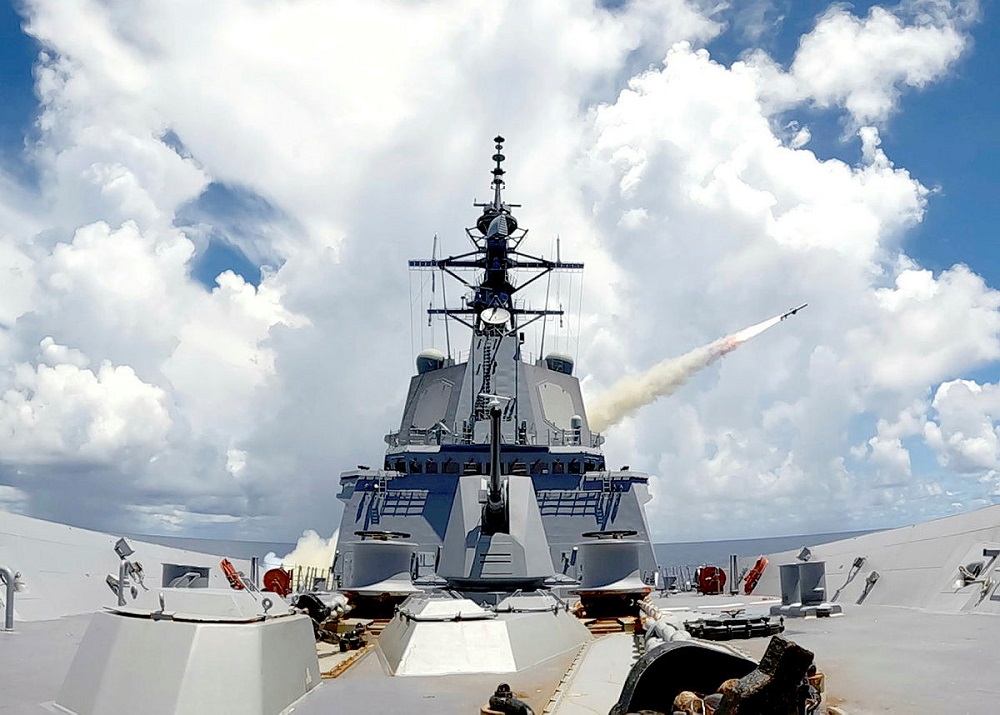
The analysis of the Royal Australian Navy’s surface combatant fleet that flowed from the defence strategic review (DSR) has been presented to the government but no decisions on new capabilities will be announced until 2024. That’s likely to align with the release of the national defence strategy and probably the 2024–25 federal budget. In the meantime, Australia’s strategic outlook continues to deteriorate and time is not our friend.
The fleet review has generated intense public debate about so-called Tier 2 vessels, specifically the potential role, value and risks should the RAN acquire corvettes to complement so-called Tier 1 vessels, such as the Hobart-class air warfare destroyers and the planned Hunter-class frigates. The Hunter’s future is uncertain pending the government’s response to the review.
One side of the debate calls for a bigger navy with a large number of smaller vessels armed with long-range missiles. There’s also recognition that building more Arafura-class offshore patrol vessels that are seriously under-gunned and incapable of contributing to high-intensity naval operations makes little sense for a navy committed to ‘deterrence by denial’.
The DSR suggested a traditional ‘high–low’ mix comprising the three Hobart-class ships and however many Hunter-class frigates are eventually acquired (if any), or an alternative to the Hunters. These Tier 1 ships would be complemented by a larger number of smaller corvette-type vessels armed with missiles. It’s pretty much more of the same, with the lower-end-capability vessels much more heavily armed than the Arafura class, which were originally envisaged in the 2020 defence strategic update.
Such an approach appears to exclude consideration of the benefits of acquiring larger vessels with greater long-range firepower—what might be termed ‘Tier 1 plus’ or ‘Tier 1 heavy’. That would not have to be at the expense of a fleet of missile-armed corvettes. Adding a third tier that mirrors Tier 2 but strengthens the RAN’s ability to strike with greater weight of fire at longer range should be debated.
The first justification for Tier 1 plus is our strategic context, which the DSR notes is driven by major-power competition and the growing risk of conflict. The DSR identifies China’s rapid military modernisation as a key issue, saying it’s occurring ‘without transparency or any reassurance of strategic intent’.
Among Australia’s allies, there’s great concern that China intends to take Taiwan and then dominate the Indo-Pacific with a blue-water navy. That possibility should give pause to any naval planners opting for smaller and less-well-armed vessels, even in greater numbers.
China’s ability to extend and intensify its anti-access and area-denial (A2/AD) envelope is clear. Chinese aircraft, surface warships, submarines and land-based rocket forces can direct long-range anti-surface-warfare weapons against RAN ships. China’s A2/AD capabilities are growing rapidly along with a ‘sensor to shooter’ kill chain, employing space, counterspace, electronic warfare, cyber and autonomous systems that can operate at increasing range. The addition of swarming lethal autonomous systems raises the prospect of multiple threats operating in many dimensions at very high speed and great range.
Naval vessels are slow compared to aircraft and more easily detected by space-based or near-space-based sensors. If a vessel can be detected, it can be tracked and, ultimately, attacked and sunk. Naval stealth is not very effective and small corvettes will be just as detectable as major surface combatants. In an age of anti-ship ballistic missiles, and soon hypersonic cruise missiles, the smaller combatant with fewer missile launchers for defence and attack is likely to be more vulnerable than a larger platform with more powerful sensors and greater firepower that may include directed-energy weapons.
South Korea has floated a concept for a Tier 1 plus warship it’s calling the joint strike vessel. It would have significantly more virtual launching system cells than the current 48 on the Hobart class—though the designer of the Hunter, BAE Systems Australia, has suggested increasing that to 96 or 128. The US Navy’s Arleigh Burke Flight III destroyers have 96 cells and China’s Type 055 Renhai class cruisers have 112.
Those promoting a Tier 2 solution argue that a greater number of smaller surface combatants could be distributed lethally through the archipelago to Australia’s north. But these are not the days of World War II torpedo boats hiding among islands to attack an enemy fleet at night. Small combatants are likely to be vulnerable to missile attack once they’re detected. That threat will only increase with swarming autonomous weapons and surveillance platforms with increasing range and endurance.
In contrast, the notional Tier 1 plus warship could potentially be seen as an arsenal ship with minimal crew and maximum firepower to defend other vessels in a taskforce. They’d be equipped for long-range strike with Tomahawk land-attack missiles, long-range loitering munitions and ultimately hypersonic weapons. Directed-energy weapons could include high-energy lasers able to engage even hypersonic targets. Smaller ships will lack such capabilities because their size constrains both firepower and energy for sensors and systems.
The RAN also faces workforce challenges, like the rest of the Australian Defence Force. Relying on a greater number of smaller ships such as corvettes is likely to demand more personnel than a small number of large strike vessels exploiting automation to reduce their human complements. There’s also the possibility of autonomous systems, including uncrewed surface vessels. Naval planners need to consider how crewed surface combatants, large and small, will work with uncrewed systems on the surface, in the air and under the waves. There are challenges here, and naval officer Jennifer Parker expertly addresses these risks.
The greatest risk in the surface combatant analysis is that planners fall back on orthodox and traditional approaches to future naval capability rather than being prepared to embrace new ideas. The arsenal ship concept was floated by the US Navy but never went beyond the conceptual stage. South Korea is being more innovative and daring. Australia has a choice: will it adopt more of the same or embrace a navy for the future?

